Lab Safety
Safety Procedures and Practices for Preventing Injuries Caused by Sharp Objects
"Sharp object" has remained as the top cause of accidents at HKUST in the past two consecutive years.
In fact, this was the prime cause of accidents in 10 of the past 15 years, ranging from 22% to 37% of the total accidents. This article serves as another reminder for the campus community, especially laboratory users, on ways to prevent injuries caused by sharp objects.
The sharp objects in question mainly include the following:
- Broken glass
- Cutters and blades
- Needle sticks
In preventing injuries caused by sharp objects, proper safety procedures and practices must be followed. Supervisors must ensure that such procedures and practices are understood and being adopted (through training and supervision), by students and employees.
Broken Glass
Glassware can break easily and cause injuries when they are not used or handled properly. Common accident scenarios include:
- Fitting glass tubing into a stopper (cork or rubber)
- Removing glass tubing from a stopper
- Fitting rubber tubing to glassware
- Attaching a pipette to a pipette-filler
- Cleaning glassware
- Carrying glassware
- Storing glassware/containers improperly
Most of the injuries caused by broken glass can be prevented by following proper laboratory/work practices as follows:
A. Inspect glassware
- All glassware should be checked to ensure that they are free from cracks and flaws before use
B. Disposal
- Damaged glassware should be properly disposed in the "broken glass" bin. Never dispose broken glass in ordinary waste bins.
- Never use bare hands to pick up broken glass. Pick it up with forceps or use a brush and dust pan.
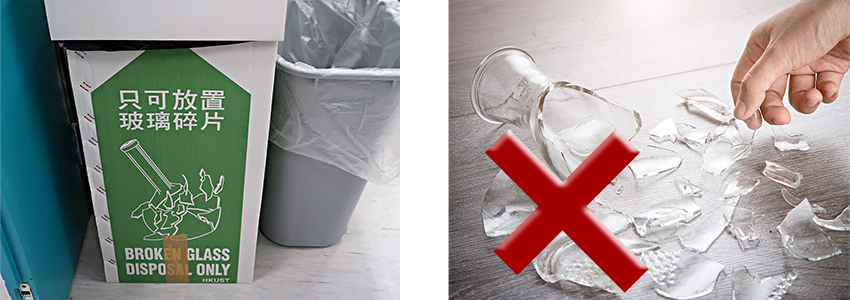
C. Fitting/Removing glass tubing

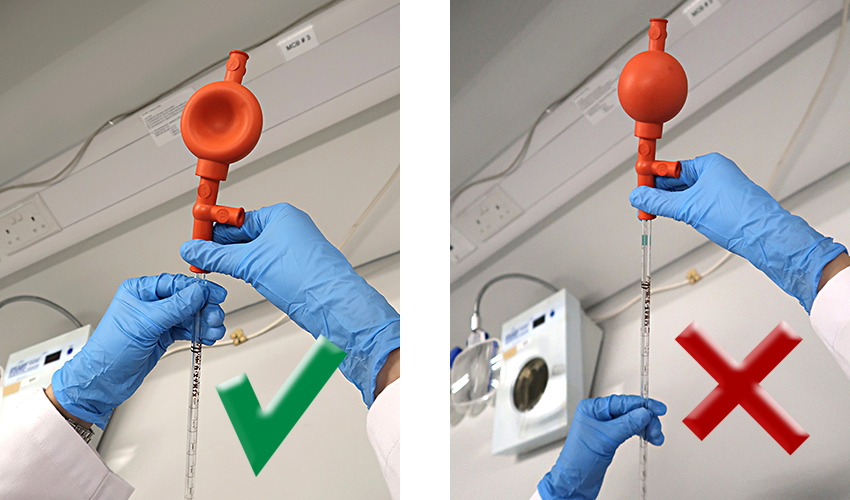
- When fitting glass tubing to corks or rubber stoppers (including fitting pipettes to bulbs or other types of pipette fillers), lubricate the end of the glass tubing (and the stopper if necessary) with water (or soap water if necessary) before inserting it into a stopper. Hold the tubing as close to the stopper as practicable and gently push the tubing into the hole. Protect your hand with a cloth and keep your palm out of the line of the glass tubing. If you need to use significant force to push the tubing, that may mean the hole is too small and needs to be enlarged.
- When removing the tubing from a stopper, again, protect your hand with a piece of cloth. If necessary, carefully cut the stopper rather than trying to reuse it.
- When fitting rubber tubing to glassware, lubricate the tip of the glassware (especially for ground glass). Soften the tubing by immersing it in hot water briefly to make it easier for the insertion.

D. Carrying glassware
- When carrying glassware, especially large ones and those containing a heavy load, use both hands with one hand placed under the base of the glassware. Do not carry a large flask only by holding its neck.
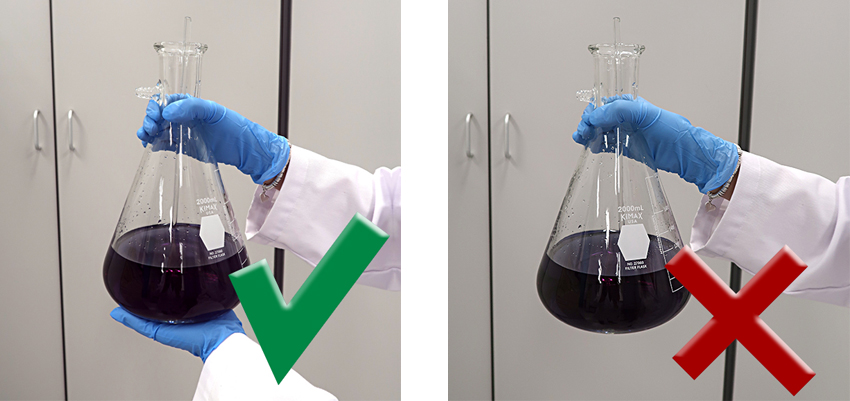
E. Cleaning glassware
- Wear heavy duty water-resistant rubber gloves for cleaning glassware. Gloves with texture or slip-resistant palms are recommended. Safety glasses should also be worn.
- Use plastic core brushes that have soft non-abrasive bristles or sponge for cleaning inside of deep glassware.
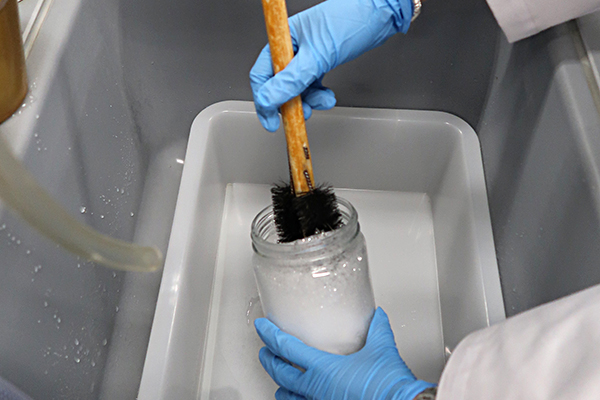

- Rubber sink and counter mats can help reduce the chance of breakage.
- Do not place round or odd shape glassware on countertops or other flat surfaces where they might roll off and break. Use proper drying racks instead.
F. Storing glassware
- Avoid storing glassware above shoulder height. Store heavy glassware at bench height. Store tall vessels at the back of shelves with smaller ones in front.
Cutters and Blades
Most injuries caused by cutters and blades are due to the use of wrong cutting tools or using the tools improperly. For example:
- Use sharp scalpels for cutting or chipping hard objects
- Applying brute force with cutting tools
- Use cutting blades without handles
- Place cutting tools improperly
- Use cutting tools without paying enough attention
Most of the injuries caused by cutters and blades can be prevented by following proper laboratory/work practices as follows:
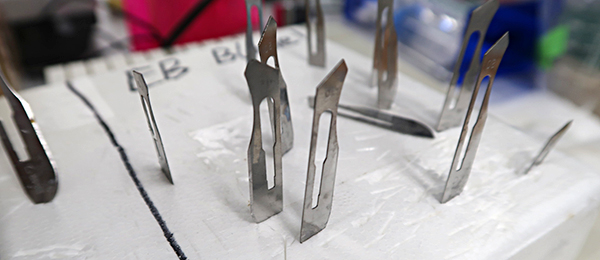
- Scalpels are extremely sharp cutting tools used for surgical operations and tissue dissection. They are not designed for cutting hard objects or heavy duty cutting tasks.
- Avoid applying brute force when using a cutter. Scalpels and paper cutters must not be used for chipping or sawing actions. The cutter blade would break or slip and cause injuries. Use other appropriate tools instead.
- Blades without a proper handle (e.g. razor blades or disposable cutter blades) must not be used for cutting tasks.

- Perform cutting tasks “defensively” with undivided attention, e.g. avoid directing the cutting tool towards your body and keep the free hand away from the cutter blade as far as practicable.
- Used cutters and blades must be placed immediately in a safe place or disposed directly into a sharps bin. Do not leave blades on work surfaces or in drawers.
- Use cut-resistant gloves where applicadle.
Needle Sticks
The following are the common circumstances for needle stick injuries:
- When fitting a needle into the syringe
- When removing a needle from the syringe
- When recapping needles
- When working with the needle with both hands. For example, when using a needle on an object (e.g. a mouse) held by the other hand, which is eventually pricked by the needle accidentally.
- Accidentally pricked by needles left around.
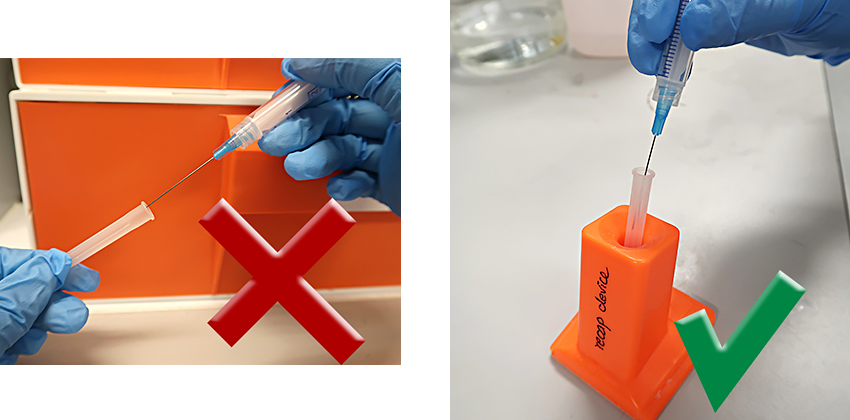
The following safety practices should be adopted to prevent needle stick injuries:
- Avoid using needles unless there is no alternative.
- Fit needle into syringe while it is still in its sheath.
- Never recap a needle unless it is absolutely essential for the process and this should be done with a device that can allow recapping to be done using one hand.
- Avoid disconnecting needle from the syringe before disposal. Discard as a single unit.
- If removing needle from the syringe is essential for the process, the needle should be recapped using the device/method mentioned in (3) above before removal.
- Keep hands behind needle tip at all times.
- Minimize handling needles with bare hands. Avoid passing a needle from hand to hand.
- Do not leave needles on work surfaces. Used needles must be disposed immediately and directly into a proper sharps bin. Never dispose needles into ordinary waste bins.
- Do not overfill a sharps bin.
